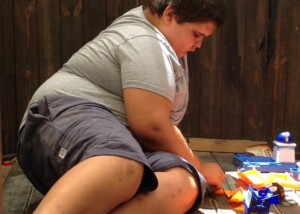Childhood obesity is overwhelmingly the result of bad diet and lack of exercise, rather than genetics or heredity.
“The CDC estimates that 18.5% of U.S. children are obese, and approximately one of every three children is overweight,” says Julie Cunningham, MPH, RD, LDN, registered dietitian and certified diabetes educator.
“The rate of childhood obesity in our country began rising in the 1970’s, which is coincidentally the same decade when fast food became widely available and when soft drink consumption increased considerably.
“Fifty years is less than one lifetime, too short of a time span for our DNA to have changed, so we can’t blame heredity for our collective obesity problem.
“Our increased consumption of grains and added sugars, combined with our lack of physical activity is the reason for overweight in both children and adults.
“We have built cities that require us to use cars instead of biking or walking, and we have chosen to eat food prepared for convenience rather than nutrition.
“My son’s elementary school had ‘walk to school’ day. The school encouraged everyone to drive to a parking lot and then walk to school from there!”
A Study Shows the Obvious
An investigation by the University of Michigan Cardiovascular Center of 1,003 sixth-graders revealed that obese kids were more likely to eat a school lunch rather than a home-prepared meal, and watch TV or play videogames two hours daily.
“For the extremely overweight child, genetic screening may be a consideration,” remarks lead study author and cardiologist Kim A. Eagle, MD, in the paper.
She adds, “For the rest, increasing physical activity, reducing recreational screen time and improving nutritional value of school lunches offers great promise to begin a reversal of current childhood obesity trends.”

Shutterstock/Natee K Jindakum
For those who believe that childhood obesity is primarily fueled by genetics, ask yourself why childhood obesity rates have soared over such a short period of time.
The obesity prevalence in American youth age six to 11 was 6.5 percent in 1980, yet a whopping 19.6 percent in 2008.
Genetics do not explain this. The explosion of computer use, however, does, along with more and more junk food TV commercials and restaurants popping up everywhere.
Look at what children did in their spare time during daylight hours 50 years ago, compared to today.
They sit before computers mindlessly eating, whereas 50 years ago they ran about outdoors or did a lot of walking collecting stones, leaves or exploring the neighborhood.
The U-M researchers showed that 58 percent of fat kids had spent two hours watching TV the previous day.
The figure for health-weight kids was 41 percent. This difference is statistically very significant.
The study showed that far fewer obese children regularly exercised, participated in gym classes or played sports.
You might argue that obesity impedes sports participation, rather than lack of sports participation causes obesity.
However, obese kids have youth on their side and can fully participate in athletics.
Though they won’t be the fastest runners or quickest movers, they still have functioning muscles and bones, and can be quite active in the field or on the court.
The diet and exercise habits of the heavy kids in this study were markedly different than those of the normal-weight children, and thus, the conclusion was that lifestyle is much more tied to obesity than are genes.
“If diets and physical activity were similar in obese and non-obese students, this would argue for a stronger genetic basis for obesity in children,” says the study paper.
The study also revealed that virtually all the participants, regardless of size, reported unhealthy habits.
Though thin kids have been known to have unhealthy diets, their portion sizes tend to be a lot smaller than those of obese children.











































